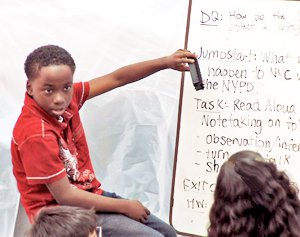Comprehensive Assessment: A Short History
Comprehensive assessment embraces the whole system of assessing student understanding as a mechanism to improve teaching and learning.
In the early 20th century, public education embraced a number of innovations that were grounded in the best thinking of the day. Many of these newfangled ideas focused on efficiency, with the goal of mass-producing students who could read, write, and compute at a basic level. As the book How People Learn explains:

It was only logical to develop standardized tests that could scientifically measure the “product” rolling off this educational assembly line.
Fast-forward to the 21st century, and basic literacy, numeracy, and content knowledge are no longer enough. According to the editors of How People Learn, and many other experts, if students are going to be able to negotiate the complexities of contemporary life, they need to be able to think and read critically, express themselves using digital tools, and solve complex problems. It’s not enough for students to be able to recall what they have memorized; they need to be able to transfer what they have learned to new situations. This calls for applying the best thinking of today -- from fields such as cognitive science and educational technology -- to update our approaches for teaching and assessing what students know and are able to do.
Comprehensive Means Everything
Assessment is an umbrella term. Grant Wiggins and Jay McTighe, authors of Understanding by Design, explain that it includes many methods of gathering evidence about student learning. These include observations and dialogues, traditional quizzes and tests, performance tasks and projects, as well as students’ reflections on their own learning.
Some methods of evidence-gathering happen while learning is still unfolding (formative assessment), helping to inform and adjust instruction. Other methods occur at the end of a course or unit of study (summative assessment) and assess whether students have reached the intended learning goals. Some methods are informal while others come with high stakes. Yet all kinds of assessment play a role in shaping understanding. Indeed, in Understanding by Design, Wiggins and McTighe state: “Understanding can be developed and evoked only through multiple methods of ongoing assessment, with far greater attention paid to formative (and performance) assessment than is typical.”
When used effectively, assessment can facilitate high levels of student achievement, according to the authors of Knowing What Students Know. Assessment helps students learn and succeed in school “by making as clear as possible to them, their teachers, and other education stakeholders the nature of their accomplishments and the progress of their learning.”
Comprehensive assessment entails the whole system of assessing student understanding as a mechanism to improve teaching and learning. Teachers use multiple strategies to gather and share information about what students understand and to identify where they may be struggling. Well-designed assessments help students chart their own progress toward learning goals and help teachers modify instruction as needed.
Authentic assessment (or performance assessment) asks students to demonstrate their learning by making a product or by doing a task, performance, or exhibition to show what they know and can do. Authentic assessment mirrors what happens in the real world when scientists, architects, musicians, and others apply their discipline-based knowledge to solve authentic challenges. In project-based learning, projects typically conclude with an authentic performance or presentation. Typically, teachers score authentic assessments according to rubrics that define quality work or proficiency according to various categories (such as mastery of key content, communication skills, teamwork, and so forth).
Blended assessment is a combination of traditional and technology-based assessments, for instance, combining paper-and-pencil tasks, online tasks, and peer assessment.